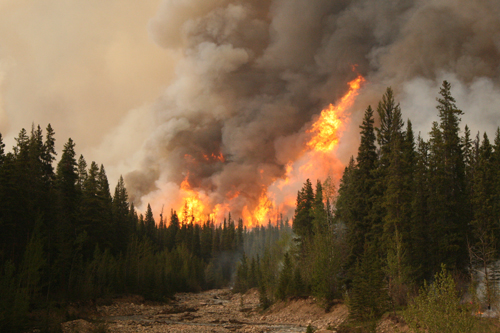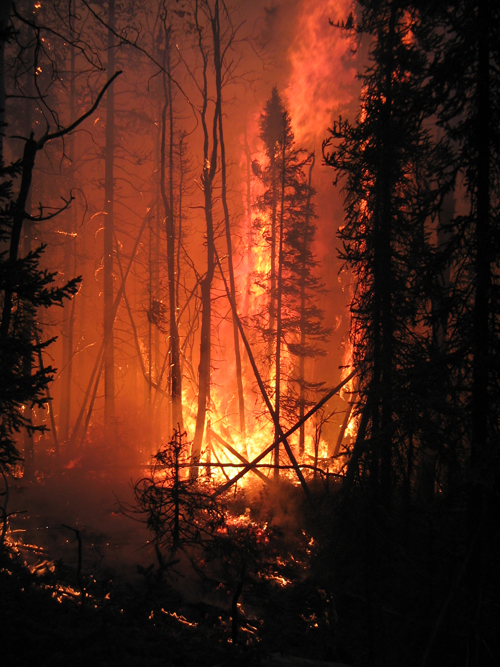Accelerated Wildfires Unlocking Carbon in Alaskan Soils, Study Finds
December 06, 2010 - News Release

Photo Credit:NRCan-CFS
Climate change is causing wildfires to burn more fiercely, pumping more greenhouse gases into the atmosphere than previously thought, according to a new study to be published in Nature Geosciences this week.
This is the first study to reveal that fires in the Alaskan interior - an area spanning 18.5 million hectares - have become more severe in the past 10 years, and have released much more carbon into the atmosphere than was stored by the region’s forests over the same period.
“When most people think of wildfires, they think about trees burning, but most of what fuels a boreal fire is plant litter, moss and organic matter in surface soils,” said University of Guelph professor Merritt Turetsky, lead author of the study.
“These findings are worrisome because about half the world’s soil carbon is locked in northern permafrost and peatland soils. This is carbon that has accumulated in ecosystems a little bit at a time for thousands of years, but is being released very rapidly through increased burning.”
The results of this study are important for countries currently meeting in Mexico for climate talks, added the integrative biology professor.
“Essentially this could represent a runaway climate change scenario in which warming is leading to larger and more intense fires, releasing more greenhouse gases and resulting in more warming. This cycle can be broken for a number of reasons, but likely not without dramatic changes to the boreal forest as we currently know it.”
This study is part of a growing body of evidence that northern systems are bearing the brunt of climate change, said co-author Jennifer Harden, a U.S. Geological Survey scientist.
“This includes longer snow-free seasons, changes in vegetation, loss of ice and permafrost, and now fire, which is shifting these systems from a global carbon sink toward a carbon source.”
The researchers visited almost 200 forest and peatland sites shortly after blazes were extinguished to measure how much biomass burnt.
“We’ve been chasing fires in this region for a number of years, which is how we amassed this unique data set,” said Turetsky.
They also looked at fire records kept since the 1950s.
“Over the past 10 years, burned area has doubled in interior Alaska, mostly because of increased burning late in the fire season,” said co-author Eric Kasischke, a University of Maryland professor. “This is the first study that has demonstrated that increases in burned area are clearly linked to increases in fire severity. This not only impacts carbon storage, but also will accelerate permafrost loss and changes in forest cover.”
More severe burning also raises a number of health concerns, as fire emissions contain mercury and particulate matter that can cause respiratory issues, said Turetsky.
“We are hoping people will recognize the seriousness of climate change for northern regions and people living in them. Wildfire is going to play a more and more important role in shaping the north.”

Photo Credit: David Wright, U.S. Forest Service
For media questions, contact Communications and Public Affairs: Lori Bona Hunt, 519-824-4120, Ext. 53338, or lhunt@uoguelph.ca, or Deirdre Healey, Ext. 56982 or dhealey@uoguelph.ca.
Contacts:
Merritt Turetsky
University of Guelph, Ontario, Canada
mrt@uoguelph.ca
519-824-4120, Ext. 56166
Jennifer Harden
U.S. Geological Survey, California
jharden@usgs.gov
650-329-4949
Eric Kasischke
University of Maryland, Maryland
ekasisch@umd.edu
301-405-2179
Roger Ottmar
U.S. Forest Service, Pacific Northwest Research Station, Washington
rottmar@fs.fed.us
206-732-7826